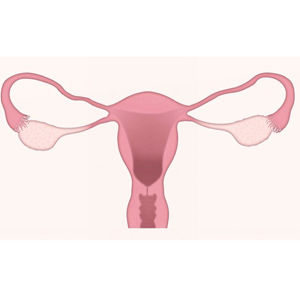Recurrence and 5-year survival rate in patients with borderline ovarian tumors and related factors in Kurdistan

Accepted: 29 August 2022
HTML: 57
All claims expressed in this article are solely those of the authors and do not necessarily represent those of their affiliated organizations, or those of the publisher, the editors and the reviewers. Any product that may be evaluated in this article or claim that may be made by its manufacturer is not guaranteed or endorsed by the publisher.
The aim of this study was to investigate the recurrence rate and five-year survival in patients with borderline ovarian tumors and related factors. This retrospective cohort study was performed on 20 women diagnosed with a borderline ovarian tumor in Kurdistan province, Iran, between 2007 and 2019. Patients' records were reviewed and a researcher-made questionnaire was completed for each patient, which included demographic and clinical variables related to patient survival. The most common type of ovarian borderline tumor was the serous borderline ovarian tumor (75%). In fifty percent of the cases, cystectomy was used as th treatment. Recurrence was observed in three patients (15%), two of which were treated with cystectomy, and the other case was treated by TAH + BSO method (p = 0.64). There was no significant difference in terms of the type of surgery, history of infertility, history of taking contraceptive pills, age, age at diagnosis, and BMI between the two groups with and without recurrence (p > 0.05). The overall survival rate was 100% and none of the patients died at the end of follow-up. There was no relationship between any of the clinical and demographic variables with disease recurrence, and since all patients were alive after the end of the follow-up period. In summary, it was not possible to assess the relationship between patients' survival rate and studied variables.
Lalwani N, Prasad SR, Vikram R, Shanbhogue AK, Huettner PC, Fasih N. Histologic, molecular, and cytogenetic features of ovarian cancers: implications for diagnosis and treatment. Radiographics. 2011;31:625-46. DOI: https://doi.org/10.1148/rg.313105066
Kanat-Pektas M, Ozat M, Gungor T, Dikici T, Yilmaz B, Mollamahmutoglu L. Fertility outcome after conservative surgery for borderline ovarian tumors: a single center experience. Arch Gynecol Obstet. 2011;284:1253-8. DOI: https://doi.org/10.1007/s00404-010-1804-7
Rauh-Hain JA, Krivak TC, Del Carmen MG, Olawaiye AB. Ovarian cancer screening and early detection in the general population. Rev Obstet Gynecol. 2011;4:15-21.
Reid BM, Permuth JB, Sellers TA. Epidemiology of ovarian cancer: a review. Cancer Biol Med. 2017;14:9-32. DOI: https://doi.org/10.20892/j.issn.2095-3941.2016.0084
Lawton FG, Pavlik EJ. Perspectives on Ovarian Cancer 1809 to 2022 and Beyond. Diagnostics (Basel). 2022;12. DOI: https://doi.org/10.3390/diagnostics12040791
Fischerova D, Zikan M, Dundr P, Cibula D. Diagnosis, treatment, and follow-up of borderline ovarian tumors. Oncologist. 2012;17:1515-33. DOI: https://doi.org/10.1634/theoncologist.2012-0139
Harter P, Sehouli J, Vergote I, Ferron G, Reuss A, Meier W, et al. Randomized Trial of Cytoreductive Surgery for Relapsed Ovarian Cancer. N Engl J Med. 2021;385:2123-31. DOI: https://doi.org/10.1056/NEJMoa2103294
Seong SJ, Kim DH, Kim MK, Song T. Controversies in borderline ovarian tumors. J Gynecol Oncol. 2015;26:343-9. DOI: https://doi.org/10.3802/jgo.2015.26.4.343
Abascal-Saiz A, Sotillo-Mallo L, de Santiago J, Zapardiel I. Management of borderline ovarian tumours: a comprehensive review of the literature. Ecancermedicalscience. 2014;8:403.
Patrono MG, Minig L, Diaz-Padilla I, Romero N, Rodriguez Moreno JF, Garcia-Donas J. Borderline tumours of the ovary, current controversies regarding their diagnosis and treatment. Ecancermedicalscience. 2013;7:379.
Loizzi V, Selvaggi L, Leone L, Latorre D, Scardigno D, Magazzino F, Cormio G. Borderline epithelial tumors of the ovary: Experience of 55 patients. Oncol Lett. 2015 Feb;9(2):912-914. Epub 2014 Dec 2. DOI: https://doi.org/10.3892/ol.2014.2758
Karimi Zarchi M, Mehdizadeh Kashi A, Allahqoli L, Sadat Tabatabai R, Shamsi F, Hashemian Asl N. The Recurrence and 5-Year Survival Rates in Patients with Borderline Ovarian Tumors in Yazd from 2006 to 2016. Journal of Obstetrics, Gynecology and Cancer Research (JOGCR). 2019;4:57-61. DOI: https://doi.org/10.30699/jogcr.4.2.57
Momenimovahed Z, Tiznobaik A, Taheri S, Salehiniya H. Ovarian cancer in the world: epidemiology and risk factors. Int J Womens Health. 2019;11:287-99. DOI: https://doi.org/10.2147/IJWH.S197604
Morris RT, Gershenson DM, Silva EG, Follen M, Morris M, Wharton JT. Outcome and reproductive function after conservative surgery for borderline ovarian tumors. Obstet Gynecol. 2000;95:541-7. DOI: https://doi.org/10.1097/00006250-200004000-00012
Sanci M, Gultekin E, Cingillioglu B, Gultekin OE, Ozvural S, Emirdar V, et al. Second primary cancers following borderline ovarian tumors. Arch Gynecol Obstet. 2011;283:1391-6. DOI: https://doi.org/10.1007/s00404-010-1585-z
Sobiczewski P, Kupryjanczyk J, Michalski W, Śpiewankiewicz B. The Evaluation of Risk Factors Associated With Relapse and Recurrence of Borderline Ovarian Tumors With Long-Term Follow-up. Int J Gynecol Cancer. 2016;26:1053-61. DOI: https://doi.org/10.1097/IGC.0000000000000722
Yasmeen S, Hannan A, Sheikh F, Syed AA, Siddiqui N. Borderline tumors of the ovary: A clinicopathological study. Pak J Med Sci. 2017;33:369-73. DOI: https://doi.org/10.12669/pjms.332.11847
Auer K, Bachmayr-Heyda A, Aust S, Sukhbaatar N, Reiner AT, Grimm C, Horvat R, Zeillinger R, Pils D. Peritoneal tumor spread in serous ovarian cancer-epithelial mesenchymal status and outcome. Oncotarget. 2015 Jul 10;6(19):17261-75. DOI: https://doi.org/10.18632/oncotarget.3746
Cadoo K, Simpkins F, Mathews C, Liu YL, Provencher D, McCormick C, ElNaggar AC, Altman AD, Gilbert L, Black D, Kabil N, Bennett J, Munley J, Aghajanian C. Olaparib treatment for platinum-sensitive relapsed ovarian cancer by BRCA mutation and homologous recombination deficiency status: Phase II LIGHT study primary analysis. Gynecol Oncol. 2022 Sep;166(3):425-431. Epub 2022 Jul 5. DOI: https://doi.org/10.1016/j.ygyno.2022.06.017
Lapke N, Chen CH, Chang TC, Chao A, Lu YJ, Lai CH, Tan KT, Chen HC, Lu HY, Chen SJ. Genetic alterations and their therapeutic implications in epithelial ovarian cancer. BMC Cancer. 2021 May 4;21(1):499. DOI: https://doi.org/10.1186/s12885-021-08233-5
Lu H, Cunnea P, Nixon K, Rinne N, Aboagye EO, Fotopoulou C. Discovery of a biomarker candidate for surgical stratification in high-grade serous ovarian cancer. Br J Cancer. 2021;124:1286-93. DOI: https://doi.org/10.1038/s41416-020-01252-2
Copyright (c) 2022 The Authors

This work is licensed under a Creative Commons Attribution-NonCommercial 4.0 International License.
PAGEPress has chosen to apply the Creative Commons Attribution NonCommercial 4.0 International License (CC BY-NC 4.0) to all manuscripts to be published.


 https://doi.org/10.4081/ejtm.2022.10779
https://doi.org/10.4081/ejtm.2022.10779



